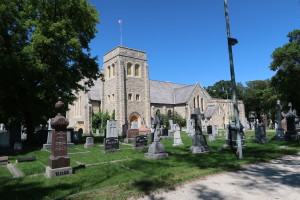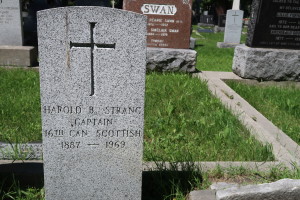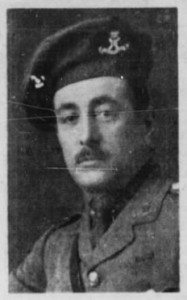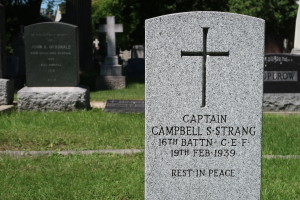
Saint John’s Anglican Cathedral Cemetery, Winnipeg.
(P. Ferguson image, July 2017)
The Strang Brothers
Some years ago, a decision was made to visit Winnipeg and have a wander about over a three-day period. The visit was our typical exploration of a city, its cemeteries, historical sites and points of interest. Much was learned as both new names of interest and familiar ones were brought to light. So too many images were gathered and recently, whilst contemplating tags and metadata, I came across some of the pictures taken at Saint John’s Anglican Cathedral Cemetery.
Of interest for today are the markers of the Strang brothers, former officers of the 16th Canadian Infantry Battalion. Both brothers include the given name of Sinclair; being the maiden name of their mother, Ann Harriet Strang.

Marker of Captain Harold Beresford Sinclair Strang.
(P. Ferguson image, July 2017)
Captain Harold Beresford Sinclair Strang 1887 – 1969
Originally a Lieutenant with the 43rd Canadian Infantry Battalion, Harold was transferred to the 16th Battalion serving in France from 13 October 1915. On 4 September 1916 at La Boiselle he received gun shot wounds to both legs, the left leg being amputated. In December 1917 Harold was awarded the Russian Order of St. Stanislaus, 3rd Class with swords and bow.

Captain Campbell Sinclair Strang.
(Winnipeg Tribune, 20 February 1939, p. 18)
Captain Campbell Sinclair Strang 1878 – 1939
A Canadian Mounted Rifles veteran of the Boer War Campbell Strang was an accomplished horseman who in his youth bred dogs and much later canaries. His birds were known to international fanciers who exhibited at events in Europe and the United States. Strang’s horses were equally well known. In Winnipeg, his horse Catbouche was a prize winner in local show circles and during the Great War his horse Sheila was considered one of the finest show horses in the British Army.
Soon after the outbreak of Great War in August 1914, Strang volunteered and was sent for training at Valcartier. Initially with the 6th Battalion CEF (Fort Garry Horse) he subsequently joined the 27th Battalion serving with them in France before proceeding to the 16th Battalion. His portrait photograph shows him wearing the insignia of the 16th Battalion with whom he served 8 November 1916 to 19 October 1917. He was a member of the 16th Battalion Veterans Association. A third brother, Robert Sinclair Strang, known as Robin, also served in the Canadian Expeditionary Force.

Marker of Captain Campbell Sinclair Strang.
(P. Ferguson image, July 2017)
Tags: 16th Battalion Veterans Association, 16th Canadian Infantry Battalion (The Canadian Scottish), Amputation, Campbell Sinclair Strang, Harold Beresford Sinclair Strang, Honours and Awards, La Boiselle, Robert "Robin" Sinclair Strang, St. John's Anglican Cathedral (Winnipeg)
This entry was posted by pferguson
on Sunday, February 21st, 2021 at 4:07 pm and is filed under Remember Them Well.
You can follow any responses to this entry through the RSS 2.0 feed.
You can leave a response, or trackback from your own site.
About The Author

Paul has worked with the Paradigm Motion Picture Company since 2009 as producer, historian and research specialist. Paul first met Casey and Ian WIlliams of Paradigm in April 2007 at Ieper (Ypres), Belgium when ceremonies were being held for the re-dedication of the Vimy Memorial, France.
Paul's sensitivity to film was developed at an early age seeing his first films at RCAF Zweibrucken, Germany and Sardinia. Paul returned to Canada in 1967 and was captivated by David Lean's "Lawrence of Arabia" and "Bridge on the River Kwai". Over time Paul became increasingly interested in storytelling, content development, character, direction, cinematography, narration and soundtracks.
At the University of Victoria, Paul studied and compared Japanese and Australian film and became interested in Australian film maker Peter Weir and his film "Gallipoli" (1981). Paul was inspired when he learned Weir visited the beaches, ridges and ravines of the peninsula. "Gallipoli", the film, led Paul on many journeys to sites of conflict in England, France, Belgium, Holland, Germany, Malta, Hawaii, Gallipoli, North Macedonia and Salonika.
When Paul first watched documentary filmmaker Ken Burns, "The Civil War", Paul understood how his own experience and insight could be effective and perhaps influential in film-making. Combining his knowledge of Museums and Archives, exhibitions and idea strategies with his film interests was a natural progression.
Paul thinks like a film-maker. His passion for history and storytelling brings to Paradigm an eye (and ear) to the keen and sensitive interests of; content development, the understanding of successful and relational use of collections, imagery and voice. Like Paul's favorite actor, Peter O'Toole, Paul believes in the adage “To deepen not broaden.”
While on this path Paul always remembers his grandmother whose father did not return from the Great War and how his loss shaped her life and how her experience continues to guide him.





Comments